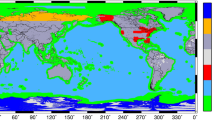Abstract
We investigated the dependence of the geomagnetic activity index K p on the velocity and density of the solar wind and the intensity of the interplanetary magnetic field (IMF). A three-layer neural network was used to create the model. The degree of the influence of input parameters on K p was determined by the value of the mean and root-mean square deviations of the model index values from the real indices. It was found that the largest contribution to the K p index is provided by the Z component of the IMF, the velocity and density of the solar wind measured with a delay from 0 to 3 h relative to the studied value of K p, and the previous value of the index itself. For the model with such a set of input parameters, the correlation coefficient between model and real series is ±0.89. The analysis of deviations from the real values of K p showed that high indices are simulated worse than low indices. In order to solve this problem the data distribution was reduced to a uniform distribution over K p, and this considerably decreased the standard deviations for large values of K p.
Similar content being viewed by others
REFERENCES
Mayaud, P.N., Derivation, Meaning, and Usage of Geomagnetic Indices, American Geophysical Union, 1980, Ch. 8.
Gosling, J.T., McComas, D.J., Philips, J.L., et al.,Geomagnetic Activity Associated with Earth Passage of Interplanetary Shock Disturbances and Coronal Mass Ejections, J. Geophys. Res., 1991, vol. 96, pp. 7831–7839.
Tsurutani, B.T., Gonzales, W.D., Gonzales, A.L.C., et al.,Interplanetary Origin of Geomagnetic Activity in the Declining Phase of the Solar Cycle, J. Geophys. Res., 1995, vol. 100, pp. 717–733.
Koons, H.D. and Gorney, D.J., A Neural Network Model of the Relativistic Electron Flux at Geosynchronous Orbit, J. Geophys. Res., 1991, vol. 96, pp. 5549–5556.
Nagai, T., Space Weather Forecast: Predictions of Relativistic Electron Intensity at Synchronous Orbit, Geophys. Res. Lett., 1988, vol. 15, pp. 425–428.
Wu, J.-G., Lundstedt, H., Eliasson, L., et al.,Spacecraft Anomaly Forecasting Using Non-Local Environment Data, Study of Plasma and Energetic Electron Environment and Effects, ESA, Tech. Note, ESTEC/Contract, 1999, no. 11974/96/NL/JG(SC).
Boteler, D.H., Watanabe, T., and Butler, D.B., Prediction of Geomagnetically Induced Current Levels in the B.C. Hydro 599 kV System, in Solar-Terrestrial Predictions, Proc. of a Workshop at Leura, Australia, 1989, 1990, vol. 2, pp. 30–41.
Ballif, J.R., Jones, D.E., and Coleman, P.J., Jr., Further Evidence of the Correlation between Transverse Fluctuations in the Interplanetary Magnetic Field and K p, J. Geophys. Res., 1969, vol. 74, pp. 2289–2300.
Hargreaves, J.K., The Solar-Terrestrial Environment,Cambridge University Press, 1999, Ch. 8.
Snyder, C.W., Neugebauer, M., and Rao, U.R., The Solar Wind Velocity and Its Correlation with Cosmic-Ray Variations and with Solar and Geomagnetic Activity, J. Geophys. Res., 1963, vol. 68, p. 6361.
Boberg, F., Wintoft, P., and Lundstedt, H., Real Time K p Predictions from Solar Wind Data Using Neural Networks, Physics and Chemistry of Earth, 2000, vol. 25, no. 4, pp. 275–280.
Wu, J.-G. and Lundstedt, H., Real Time K p Predictions from Solar Wind Data with the Use of Dynamic Neural Networks, J. Geophys. Res., 1997, vol. 102, pp. 14255–14268.
Pudovkin, M.L., Shukhtina, M.A., Ponyavin, D.I., et al.,On the Geoefficiency of the Wind Parameters, Ann. Geophys., 1980, vol. 36, pp. 549–553.
Bishop, C., Neural Networks for Pattern Recognition, Oxford Univ. Press, 2000.
Bargatze, L.F., Baker, D.N., McPherron, R.L., et al.,Magnetospheric Impulse Response for Many Levels of Geomagnetic Activity, J. Geophys. Res., 1985, vol. 90, p. 6387.
Rights and permissions
About this article
Cite this article
Rusanov, A.A., Petrukovich, A.A. Influence of Solar Wind Parameters on the Level of Geomagnetic Field Fluctuations. Cosmic Research 42, 354–361 (2004). https://doi.org/10.1023/B:COSM.0000039734.19475.fe
Issue Date:
DOI: https://doi.org/10.1023/B:COSM.0000039734.19475.fe




